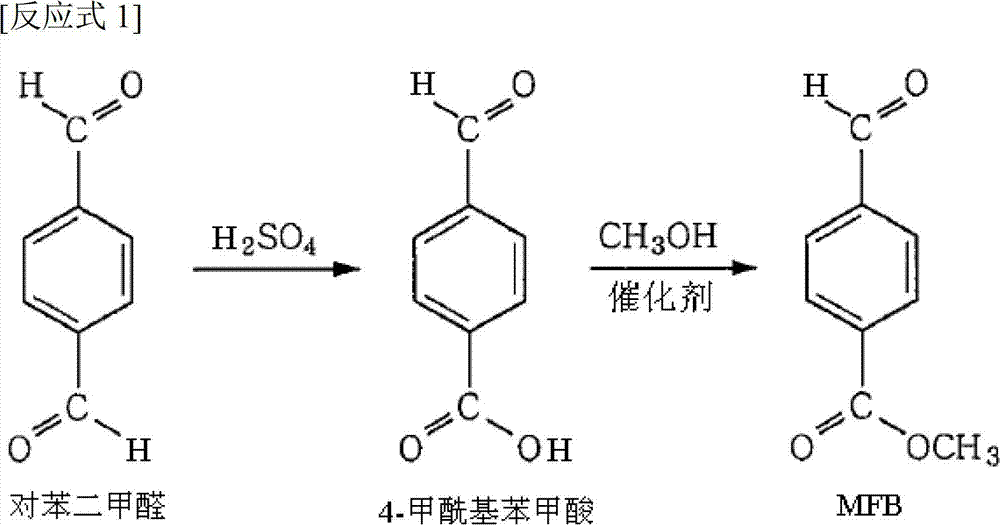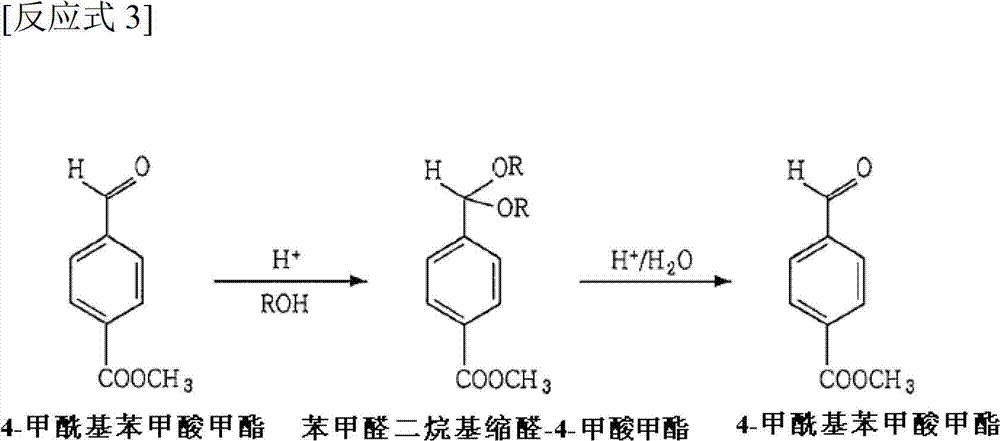The process of isolating methyl-4-formylbenzoate and dimethylterephtalate
A technology of dimethyl terephthalate and methyl formyl benzoate, applied in the field of separation and recovery of 4-formyl in the mixture of by-products, can solve the problems of unfavorable worker safety, environmental problems, corrosion reaction equipment, etc. To achieve the effect of alleviating economic and environmental problems
- Summary
- Abstract
- Description
- Claims
- Application Information
AI Technical Summary
Problems solved by technology
Method used
Image
Examples
Embodiment 1
[0035] To 100 parts by weight of a mixture containing about 63% by weight of MFB, about 30% by weight of DMT, about 6% by weight of MPT, about 1% by weight of MBZ and trace impurities is added 200 parts by weight of methanol, the mixture It is a by-product in the process of preparing DMT. The methanol solution was stirred at 25°C for 0.5 hour. After the stirring, only DMT remained as a solid, and the stirred solution was filtered to recover DMT as a solid. The solid DMT was washed with methanol, and the weight of the DMT thus obtained was 27.4 g and the purity was 99.4%.
[0036] To the obtained filtrate was added 0.2 parts by weight of hydrochloric acid (HCl), and the solution was stirred for 2 hours to convert MFB into benzaldehyde dimethylacetal-4-acetate. When the reaction product converted into benzaldehyde dimethyl acetal-4-acetate was kept at -2°C, the residual DMT was precipitated as a solid. The reaction product was filtered at -2°C to recover the remaining solid DMT....
Embodiment 2
[0039] To 100 parts by weight of a mixture containing about 63% by weight of MFB, about 30% by weight of DMT, about 6% by weight of MPT, about 1% by weight of MBZ and trace impurities is added 200 parts by weight of ethanol, the mixture It is a by-product in the process of preparing DMT. The ethanol solution was stirred at 25°C for 0.5 hour. After the stirring, only DMT remained as a solid, and the stirred solution was filtered to recover DMT as a solid. The solid DMT was washed with ethanol, and the weight of the DMT thus obtained was 25.1 g and the purity was 99.6%.
[0040] 0.2 parts by weight of hydrochloric acid (HCl) was added to the obtained filtrate, and the solution was stirred for 2 hours to convert MFB into benzaldehyde dimethyl acetal-4-acetate. When the reaction product converted into benzaldehyde dimethyl acetal-4-acetate was kept at -2°C, the residual DMT was precipitated as a solid. The reaction product was filtered at -2°C to recover the residual DMT as a soli...
Embodiment 3
[0043] MFB was recovered in the same manner as in Example 1, except that the same amount of Exelsol670 (Korea SK Company) was used instead of heptane. In this case, the purity of the recovered DMT was 99.4% and the weight was 29.8 g, and the purity of the recovered MFB was 98.8% and the weight was 39.9 g.
PUM
 Login to View More
Login to View More Abstract
Description
Claims
Application Information
 Login to View More
Login to View More - R&D
- Intellectual Property
- Life Sciences
- Materials
- Tech Scout
- Unparalleled Data Quality
- Higher Quality Content
- 60% Fewer Hallucinations
Browse by: Latest US Patents, China's latest patents, Technical Efficacy Thesaurus, Application Domain, Technology Topic, Popular Technical Reports.
© 2025 PatSnap. All rights reserved.Legal|Privacy policy|Modern Slavery Act Transparency Statement|Sitemap|About US| Contact US: help@patsnap.com



